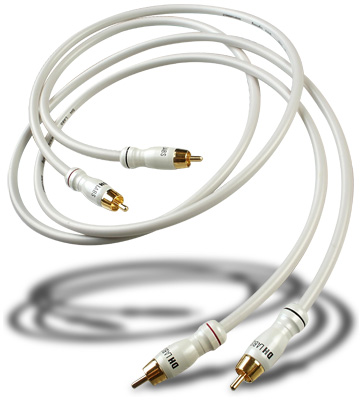August 15, 2009DH Labs Silver Sonic White
Lightning Interconnects

Category: Cables &
Accessories


|
Darren Hovsepian founded DH Labs in 1992
with the goal of creating high-performance audio and video cables that deliver the highest
possible level of sound and video quality. Since then, DHL has continually produced
high-performance and cost-effective speaker cables and interconnects that have won a wide
following in the audiophile community.
DH Labs currently offers four lines of factory-terminated
interconnect cables in its Silver Sonic brand: the Revelations, at $399 USD per 1m pair;
the Air Matrix, at $195/1m pair; the BL-1 Series II, at $99/1m pair; and finally,
replacing the Phantom, the new White Lightning, at $49.95/1m pair. Knowing DH Labs’
reputation for producing high-value cables at affordable prices, I was anxious to hear the
Silver Sonic White Lightnings.
Description and setup
Each White Lightning conductor is made of strands of
oxygen-free-copper (OFC) completely sealed in a dielectric of foam polyethylene. The
copper connectors are soldered by hand using high-purity, lead-free silver. According to
DH Labs, the White Lightning’s very heavy braided shield gives it 95% coverage and a
low capacitance of only 24pF/foot. The model’s name is printed on its pure white
jacket.
I found the White Lightning not only attractive but very
flexible; users will have little difficulty snaking this interconnect around corners or
through audio cabinets.
During my time with the White Lightnings, they mostly
linked a Sony CDP-CE375 CD changer and an Onkyo TX-SR602 receiver. The TX-SR602’s
amplifier provides 85Wpc into 8 ohms, and drives two Klipsch RF-35 floorstanding speakers.
Sound
After inserting the White Lightnings in my system, I heard
an immediate difference in output level compared to my generic cables. The DH Labs seemed
to cut the general level of distortion and damp the background noise, with the result of a
marked reduction in volume, though that reduction in noise also helped me distinguish
individual notes.
The White Lightnings provided an excellent balance of
sounds, especially in the mid to high frequencies. They were particularly efficient at
revealing the differences among specific voices in a chorus, whether instrumental or
human. I was able to distinguish specific performers in an orchestral arrangement that had
been previously unidentified.
While the White Lightnings assisted in clarifying specific
sounds in the lower frequencies, I can’t say that they enhanced that range in
any way. In fact, I found that, in their quest for perfect tonal balance, the White
Lightnings slightly marginalized the lower tones.
"February Song," from Josh Groban’s Closer
(CD, Warner Bros. 48450-2), provides a balance between piano, strings, and voice. During
Groban’s piano introduction, the White Lightning easily delineated each keystroke
with a clear reverberance that seemed to fade off into a silent background. When Groban
began to sing, the midrange was descriptive, letting me identify smaller sounds, such as
his inhalations. When the strings and the rest of the band entered, they filled out the
midrange beautifully, adding to the overall composition without overwhelming it.
Impressed, I then challenged the White Lightnings with an
excellent recording of Beethoven’s Piano Sonata No.8 in C Minor, Op.13,
"Pathétique," performed by Murray Perahia, from the soundtrack album for Immortal
Beloved (CD, Sony Classical 66301). The DH Labs provided me with yet another lovely
listening experience. While not extraordinary, the White Lightning’s ability to
reproduce the acoustic piano was surprisingly good. Not only could I hear each of the keys
being struck, but the background was so well defined that I could distinguish individual
notes while they held their place in the melody. Again I found that each of the notes in
the mid- to high range sounded more robust, adding a wonderful element of balance.
Comparison
I began my comparisons with a pair of cheap, generic cables
like those that accompany any typical audio component; I wanted to point out to novice
readers the differences, if any, that a modest investment in audio cables can make in the
overall listening experience.
With Groban’s "February Song," the no-name
cable provided a large yet undistinguished sound. When Groban began singing, it was clear
that his voice had been recorded to be the predominant one in a chorus of instruments. It
was well pronounced but tinny, and without depth. When the strings and band entered, the
generic interconnects failed at delivering an overall balanced presentation. As before,
the White Lightning produced a lower volume than the generics; however, each of
Groban’s piano keystrokes was individually detailed. The White Lightning’s
ability to accentuate the midrange was very noticeable when compared with the no-name
interconnects.
I then listened to "Attack," from Hans
Zimmer’s soundtrack score for Pearl Harbor (CD, Warner Bros. 48113-2). For
those unfamiliar with this track, I highly recommend it for a clear balance of intense
percussion backed by a full orchestra and choir. "Attack" begins with an
onslaught of percussion simulating the Japanese invasion. Switching back to the no-name
interconnects, I immediately heard an increase in volume; the combination of timpani and
bass drums was loud but muffled. A snare drum and tambourine in the background were
difficult to distinguish, as the balance seemed dominated by the lower registers. The
orchestral instruments sounded like a big melting pot of noise cumulating in a series of
high notes led by the brass, which ultimately became broken and distorted.
"Attack" proceeds into a lovely ballad led by a soloist that was entirely lost
in the orchestra’s sound. Overall, the sound through the generic interconnects was
loud, but tinny and without depth.
The White Lightnings produced a quieter, softer listening
experience, eliminating any distortion while providing a much clearer, more distinguished
sound. Through the DHLs I could identify individual drums; specifically, the snare and
tambourine stood out to lead the percussion section, providing a marked improvement in
clarity. During an orchestral crescendo about two minutes into "Attack," I was
able to distinguish each of the individual wind and brass instruments, and the
trumpets’ final notes were assertive and well defined. In the choral section, the
soloist was more dominant, with a better balance between the string instruments and the
singer’s vibrato. At no time was the voice lost in the orchestra -- quite the
opposite: the voice flowed with the melody for maximum emotional effect, something that
was completely lost with the no-name wires.
Conclusion
DH Labs’ Silver Sonic White Lightning produced crisp
sound with well-defined mid- to high frequencies. Although there was an apparent decrease
in volume when going to the White Lightnings from my generic interconnects, there was also
a noticeable reduction in distortion and background noise, and a definite increase in
resolution and detail. The subtle details were easier to hear. The White Lightnings tended
to be a bit lighter in the bass, but not to the point of imbalance.
DH Labs’ reputation is safe. They’ve created in
the Silver Sonic White Lightning, at $49.95/1m pair, an incredibly cost-effective
interconnect that gives the developing audiophile on a modest budget a great upgrade from
generic interconnects, and that will result in a greatly improved listening experience.
. . . Jarrett Dixon
Price of equipment reviewed
|















